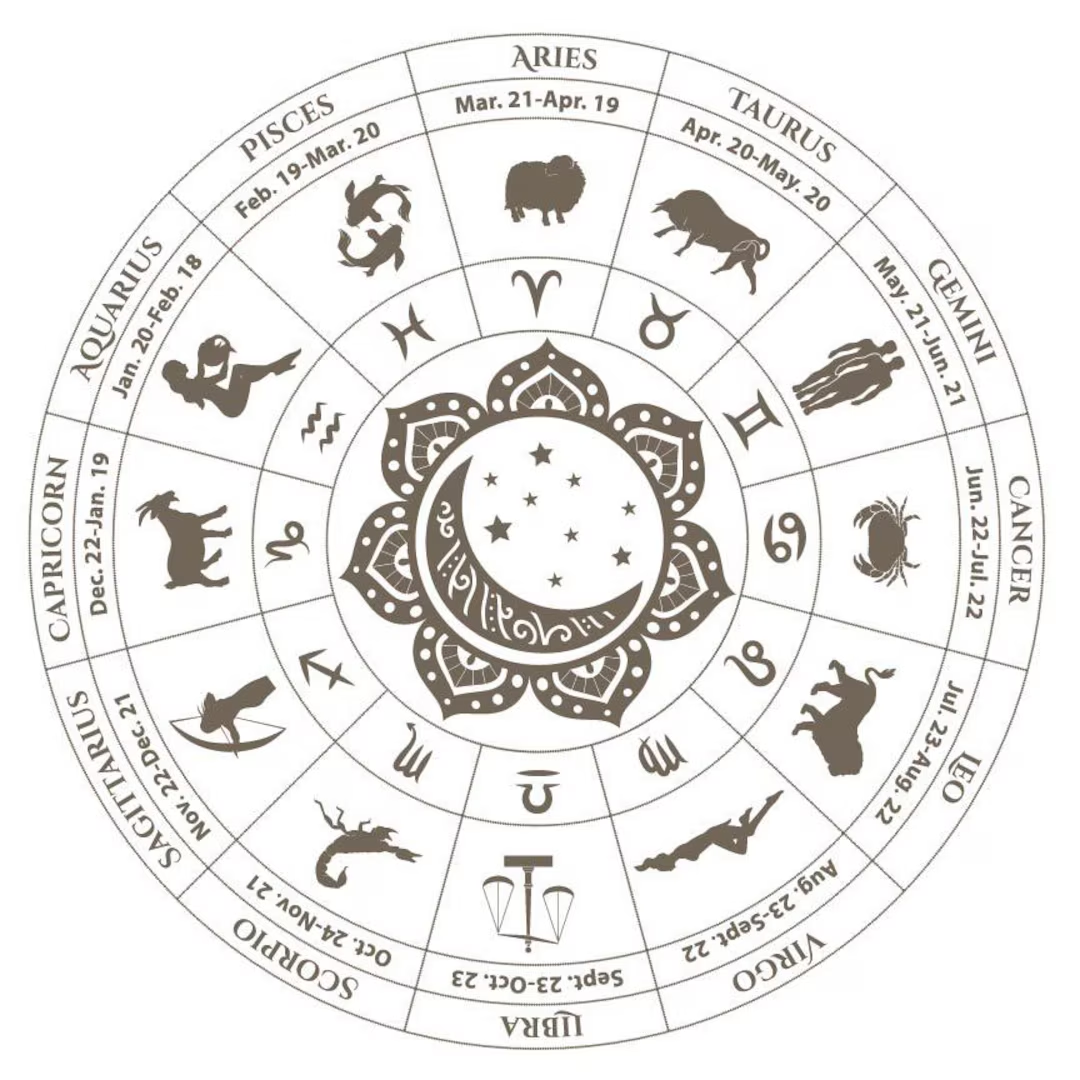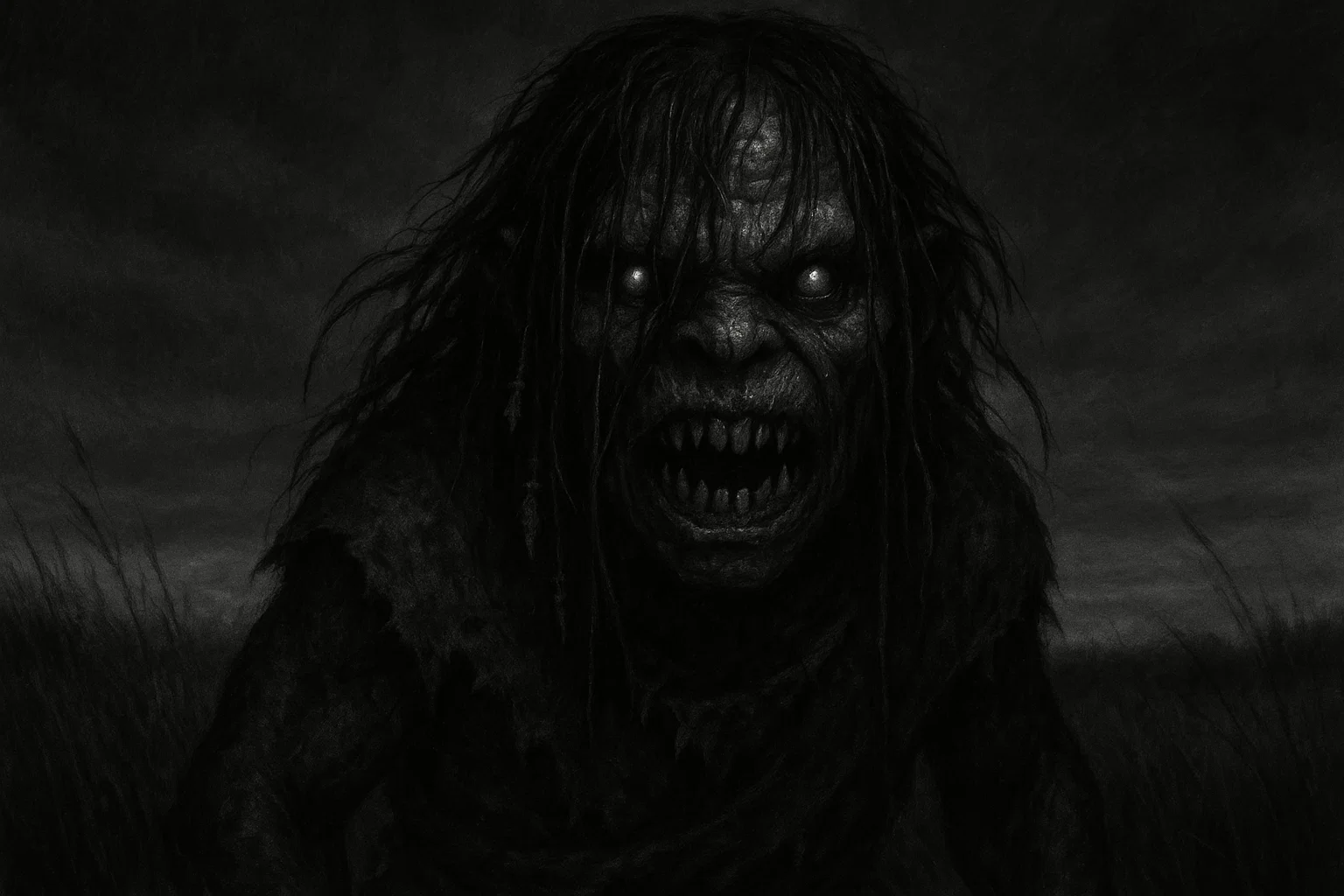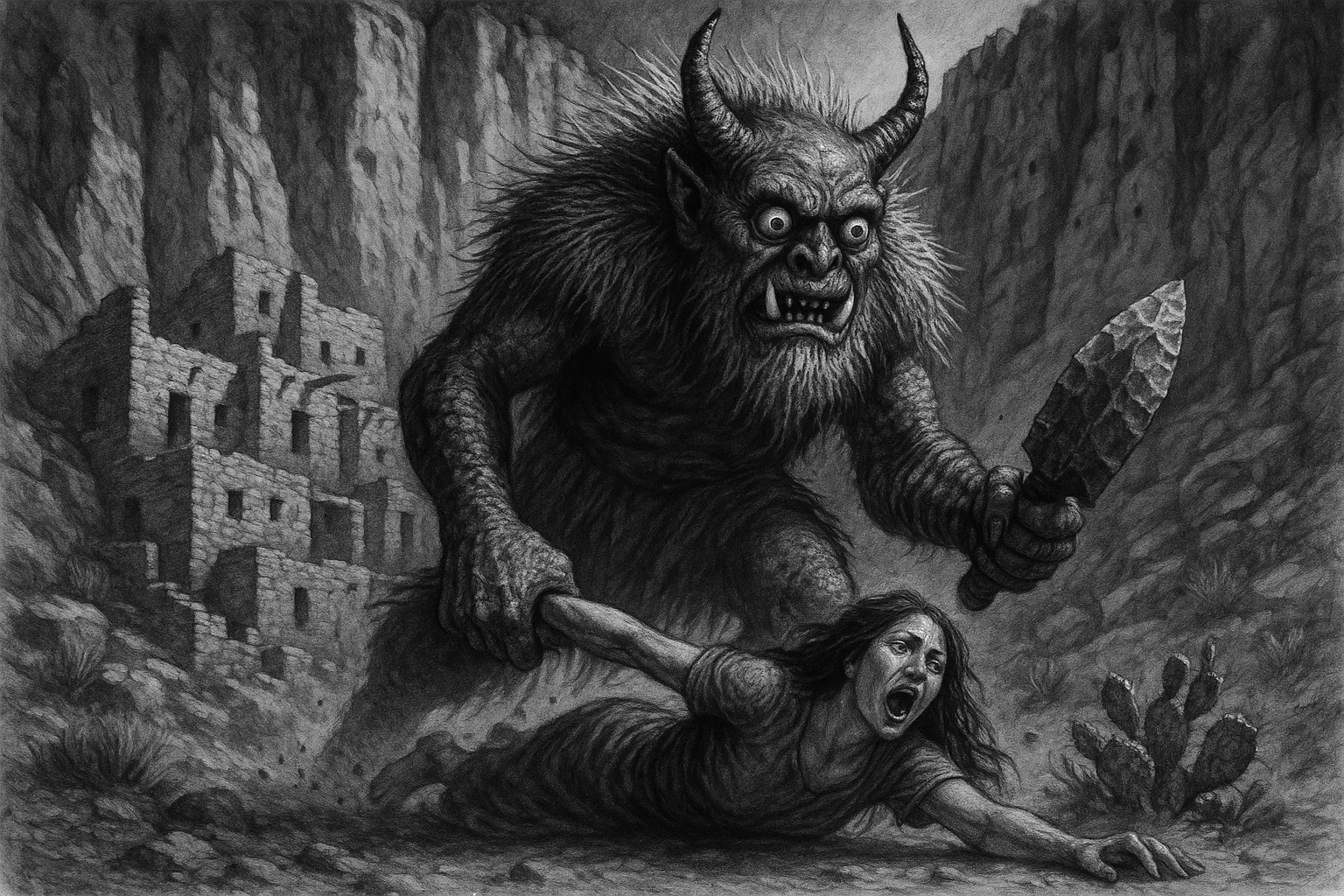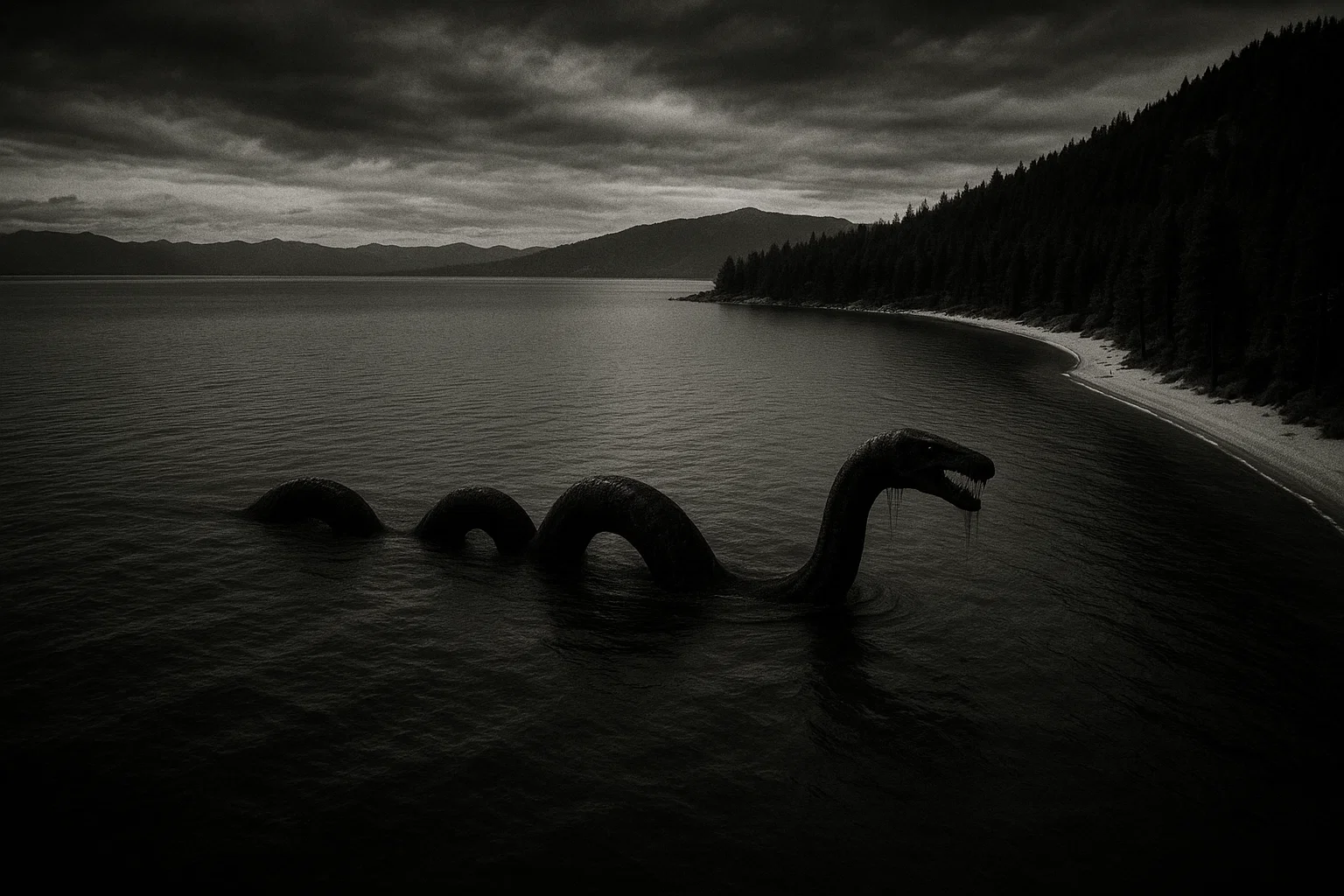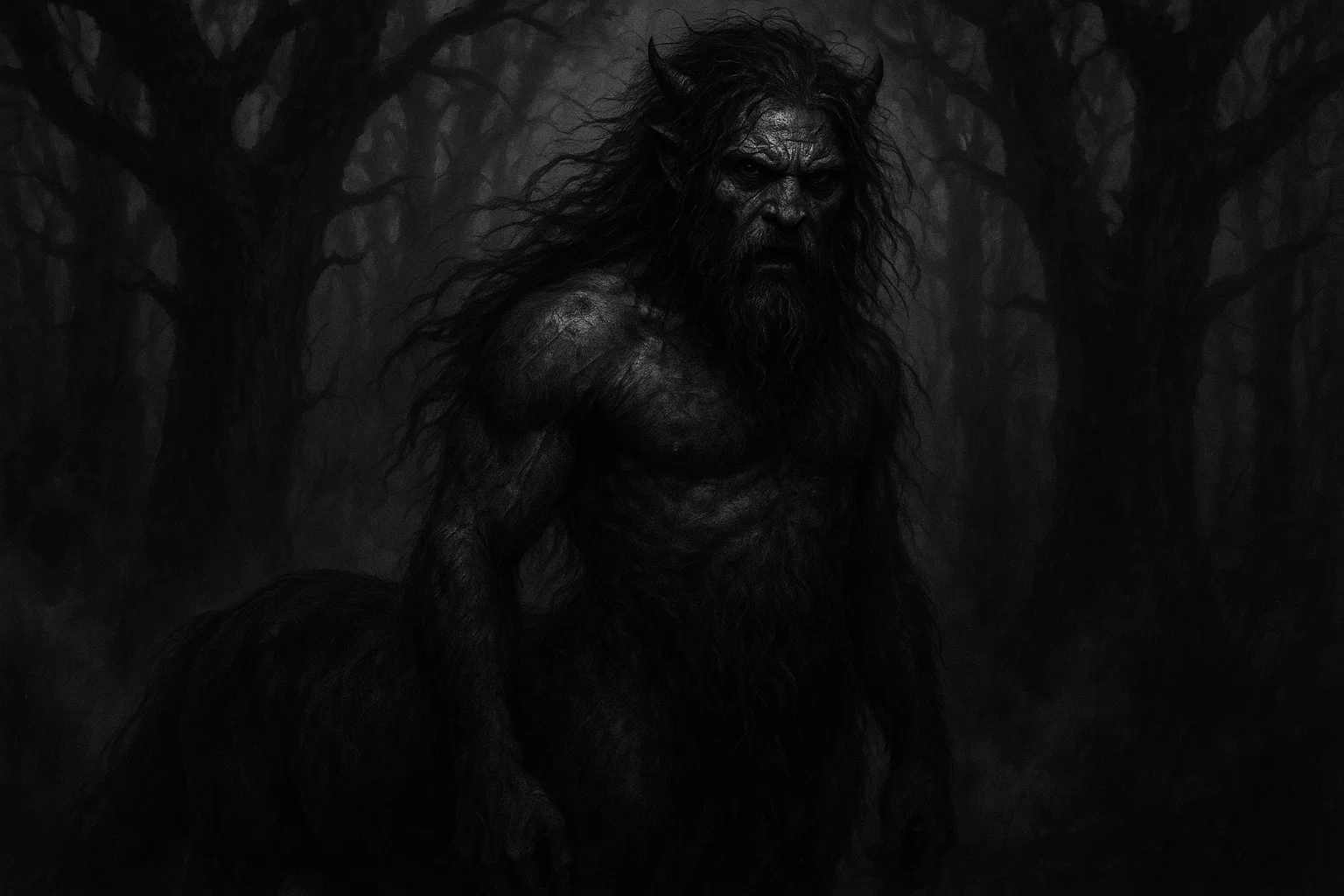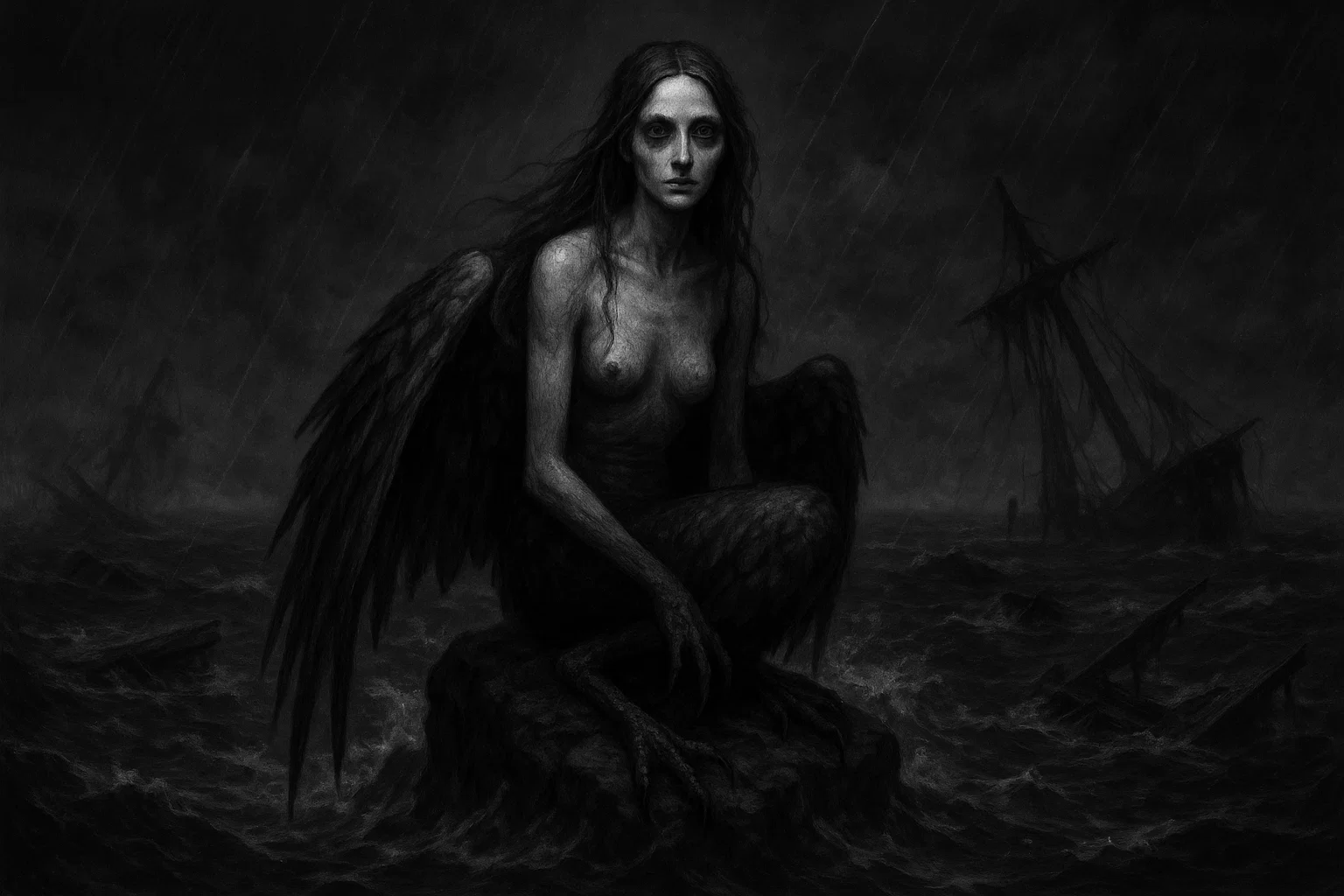The Nimerigar are a legendary race of small humanoids from the folklore of the Shoshone and Paiute tribes in the Rocky Mountains. These beings are described as aggressive warriors who stand two to three feet tall and use tiny bows with poisoned arrows to attack humans and animals.
Their name translates to “people eaters” in the Shoshone and Paiute languages, reflecting tales of cannibalism within their own society and against outsiders.
Stories of the Nimerigar have persisted among Native American communities for generations, often portraying them as enemies of larger tribes. The legends include details of their habitat in mountain ranges and their practice of killing ill members with blows to the head.
The 1932 discovery of a small mummy in Wyoming briefly linked physical evidence to these accounts. However, later scientific analysis provided alternative explanations.
Summary
Overview
| Attribute | Details |
|---|---|
| Name | Nimerigar |
| Aliases | Nunumbi, Ninimbe, Ninimpi, Little People, Enemy Dwarves |
| Threat Level | Predatory and aggressive toward humans and other creatures |
| Habitat | Rocky Mountain ranges above 2,000 ft, including Pedro Mountains and Wind River Range, Wyoming; Owyhee Mountains, Idaho |
| Physical Traits | Humanoid, 2–3 ft tall (20–36 in), sharp canine teeth, muscular build, use tiny bows and poisoned arrows |
| Reported Sightings | Pedro Mountains, Wyoming; Wind River Range, Wyoming; Owyhee Mountains, Idaho; Coshocton, Ohio (historical burial site) |
| First Documented Sighting | Pre-19th century Shoshone oral traditions; earliest written reference 1778 by David Zeisberger |
| Species Classification | Humanoid, speculative pygmy race or unknown |
| Type | Terrestrial |
| Behavior & Traits | Cannibalistic, kill ill members with head blows, raid tribes, expert archers, nocturnal and elusive |
| Evidence | Eyewitness accounts in folklore, San Pedro Mountains mummy (1932), historical burial reports |
| Possible Explanations | Misidentified small animals or humans, folklore exaggeration, anencephalic infant remains |
| Status | Ongoing mystery in Native folklore, no confirmed modern sightings |
Who or What Is a Nimerigar?
The Nimerigar are depicted in Shoshone and Paiute folklore as a race of diminutive humanoids inhabiting the Rocky Mountains. Standing between two and three feet tall, they are characterized by their fierce demeanor and use of small weapons.
Tribal stories describe them as a society that engages in raids against larger human groups, employing poisoned arrows fired from tiny bows to subdue prey.
These beings are not portrayed as benevolent spirits but as antagonists who consume human flesh. Legends state that the Nimerigar maintain their population by eliminating weak or ill individuals through fatal blows to the head, ensuring only strong members survive. This practice highlights their reputation as ruthless cannibals, with the name Nimerigar directly meaning “people eaters.”
Shoshone tales recount conflicts where tribes united to combat the Nimerigar, eventually driving them into caves or exterminating them. The persistence of these accounts across generations suggests a cultural role in explaining unexplained dangers in mountainous terrain.
While some variants from other tribes describe similar little people as tricksters or healers, the Shoshone version emphasizes hostility. The 1932 San Pedro Mountains mummy fueled speculation that these figures might stem from encounters with actual small-statured humans, though no direct proof exists.
Your Personalized, Hyper Accurate Moon & Astrology Reading
Limited time offer: Get your FREE, fully personalized Moon & Astrology Reading that takes astrology to a whole new level. Discover the secret depths of your personality, relationships, and true purpose in life.
What Does a Nimerigar Look Like?
The Nimerigar are consistently described in Shoshone folklore as small, humanoid figures resembling miniature humans. Adults measure 2 to 3 feet tall, with some accounts specifying a range of 20 to 36 inches. Their build is muscular and stocky, adapted for agility in rugged terrain. However, they lack the elongated limbs of larger primates.
Facial features include a prominent row of sharp canine teeth, which folklore attributes to their carnivorous diet. The mouth is wide and thin-lipped, with a low forehead contributing to a fierce expression. Skin tone varies in tales, but is often described as pale or weathered from mountain life, with sparse hair rather than full fur. Eyes are described as dark and piercing, suited for low-light conditions.
Clothing, when mentioned, consists of simple hides or woven materials from local flora, allowing camouflage among rocks and trees. They carry tiny bows no longer than a foot, crafted from wood and sinew, along with quivers of poisoned arrows tipped with plant toxins or animal venom.
Hands are dexterous, with five fingers, enabling precise archery despite their size. No horns, tails, or other non-human appendages appear in descriptions; the Nimerigar are fully bipedal, walking upright like humans.
Variations exist, such as seated postures in some cave depictions, but core traits remain consistent: compact, toothed, and armed.
You May Also Like: Bigfoot Sightings Across America: Full 50-State Guide
Habitat
The Nimerigar are said to reside in the high elevations of the Rocky Mountains, particularly ranges exceeding 2,000 feet.
Primary locations include the Pedro Mountains and Wind River Range in Wyoming, where Shoshone legends place their communities in hidden caves and rock crevices. These areas feature steep granite slopes, alpine meadows, and coniferous forests dominated by pine and fir trees, providing cover for small, elusive groups.
In Idaho, the Owyhee Mountains serve as an extension of their territory, with arid canyons and basalt plateaus offering defensive positions. The terrain is rugged, with elevations ranging from 5,000 to 8,000 feet, and is characterized by sparse vegetation, including sagebrush and juniper. Climate varies seasonally: harsh winters with heavy snow accumulation force the Nimerigar into sheltered caves.
At the same time, summers bring mild temperatures ideal for foraging. Water sources, such as seasonal streams and springs near cave entrances, support their needs, aligning with tales of proximity to bodies of water.
Fauna in these habitats includes deer, elk, and small mammals, which folklore claims the Nimerigar hunt with poisoned arrows. Historically sparse human settlements consist of Shoshone and Paiute villages in valleys below, leading to raids across elevation gradients.
Geological features such as lava tubes and fault-line caves provide natural fortresses where the Nimerigar allegedly stored weapons and provisions. Vegetation such as yucca and wild onion supplied materials for arrow poison, enhancing their predatory efficiency.
Proximity to larger tribal lands in Wyoming and Idaho ensured ongoing conflict, with stories of tribal wars pushing the Nimerigar deeper into uninhabited peaks.
Nimerigar Sightings
| Date | Place | Witness Details | Description | Reliability |
|---|---|---|---|---|
| Pre-19th century | Wind River Range, Wyoming | Shoshone oral historians | Group of small figures emerging from caves, firing arrows at hunters | Medium: Consistent tribal transmission, no physical corroboration |
| 1778 | Coshocton, Ohio | Missionary David Zeisberger | Burial ground with multiple 3-ft skeletons arranged in rows | Medium: Documented account, possible misinterpretation of remains |
| Early 1800s | Pedro Mountains, Wyoming | Paiute and Shoshone elders | Raiding party of 2-ft humanoids kidnapping children | Low: Folklore narrative, no independent verification |
| Mid-1800s | Owyhee Mountains, Idaho | Shoshone scouts | Cannibalistic feast observed near cave entrance | Low: Secondhand tribal report |
| 1932 | San Pedro Mountains, Wyoming | Prospectors Cecil Mayne and Frank Carr | 14-in mummy found in blasted cave, seated with adult features | High: Physical artifact examined, though later reclassified |
| 1940s | Wind River Range, Wyoming | Local ranchers | Small tracks and arrow wounds on livestock | Low: Anecdotal, possible animal misidentification |
| 1970s | Owyhee Mountains, Idaho | Hikers | Brief glimpse of 2-ft figure with bow vanishing into rocks | Low: Single sighting, no photos |
| 2000s | Pedro Mountains, Wyoming | Modern folklore collectors | Echoes of chants near historical mummy site | Low: Auditory claim, subjective |
Shoshone Tribal Accounts (Pre-19th Century, Wind River Range)
Shoshone oral histories from the 18th and early 19th centuries detail repeated encounters with the Nimerigar in the Wind River Range. Elders recounted how hunting parties stumbled upon cave clusters where small groups of the beings resided.
One prominent tale describes a Shoshone warrior tracking wounded game to a crevice, only to be ambushed by three Nimerigar firing poisoned arrows. The warrior survived after killing two with his knife, noting their sharp teeth and frantic attempts to drag his body away.
David Zeisberger’s Burial Discovery (1778, Coshocton)
In 1778, missionary David Zeisberger documented a burial site near Coshocton, Ohio, containing rows of graves for individuals approximately three feet tall. He described the skeletons as aligned with heads to the west, speculating on sun-worship practices.
Local tribes, including Delaware affiliates, linked the site to ancient little people akin to the Nimerigar, suggesting migration from the western mountains.
Zeisberger’s journal entries note the graves’ orderly arrangement and lack of larger accompanying remains, fueling theories of a pygmy race. Though not a direct sighting, the discovery paralleled Shoshone descriptions, with some bones showing cranial fractures consistent with head-blow rituals.
Modern archaeology questions the classification of pygmies as juveniles, but the account remains a cornerstone for Nimerigar proponents.
Awaken XT is unlike anything you’ve ever tried before…
…it’s based off a closely guarded formula that’s said to be able to supercharge your pineal gland and help you access your untapped inner power. With it’s unique blend of extremely hard to source ingredients, Awaken XT helps support the healthy functioning of your pineal gland, as well as your other organs in your body.
Cecil Mayne and Frank Carr’s Mummy Find (1932, San Pedro Mountains)
On October 18, 1932, gold prospectors Cecil Mayne and Frank Carr blasted into a small chamber in the San Pedro Mountains, 60 miles south of Casper, Wyoming. Inside lay a seated mummy, 14 inches tall (36 cm overall, 6.5 in seated), with adult-like features including full dentition and a low forehead.
The body showed a bashed skull, broken collarbone, and damaged spine, aligning with Nimerigar euthanasia practices.
The mummy, dubbed “Pedro,” toured as an exhibit, undergoing X-rays that revealed internal organs. Initial tests deemed it an adult male, sparking Nimerigar speculation. Shoshone representatives viewed it as confirmation of their legends.
However, 1970s re-examinations by George Gill identified it as an anencephalic Native American infant, about two weeks old, naturally mummified.
You May Also Like: The Nain Rouge: Detroit’s Dwarf Cryptid and Omen of Disaster
Modern Hikers’ Encounter (1970s, Owyhee Mountains)
In the 1970s, a group of hikers in Idaho’s Owyhee Mountains reported spotting a two-foot figure during a dusk hike. The witness, a local outfitter, described it as muscular, carrying a small bow, before it scrambled into basalt rocks. Accompanying signs included tiny footprints (3-4 inches) and a pungent odor like decaying meat.
The group searched but found no further traces, attributing arrow-like punctures on nearby rabbits to the creature.
Evidence & Investigations
Evidence for the Nimerigar primarily consists of oral folklore from Shoshone and Paiute tribes, supplemented by historical and archaeological finds.
Tribal accounts, transmitted for centuries, describe consistent physical and behavioral traits, including size, weapons, and cannibalism. These narratives, documented in ethnographic studies like those by early 20th-century anthropologists, form the bulk of the record but lack physical artifacts beyond the 1932 mummy.
The San Pedro Mountains mummy stands as the most tangible item. Discovered by prospectors Mayne and Carr, it underwent examination by the American Museum of Natural History in the 1930s.
X-rays showed a fully formed skeleton with adult proportions, sharp teeth, and trauma indicative of a head blow—mirroring Nimerigar rituals. It was displayed publicly until 1940, drawing Shoshone interest as proof of their legends.
Post-1950 investigations shifted skepticism. Anthropologist George Gill’s 1976 analysis, using advanced radiography, concluded the mummy was an anencephalic infant (missing parts of the skull and brain), naturally mummified in dry cave conditions.
Carbon dating placed it around 1930, suggesting rapid preservation. Gill noted no pygmy race indicators, attributing the adult appearance to pathology.
Other evidence includes Zeisberger’s 1778 Ohio burial report of 3-foot skeletons, later reinterpreted as child graves. Footprint casts from 1940s Wyoming ranchers measured 3-4 inches and were dismissed as animal tracks. Audio claims of chants in the 2000s remain unverified.
Cryptozoological efforts, such as Eugene Bashor’s 1990s searches in Wyoming caves, yielded no results. A 2005 reward offer for the mummy’s return (it vanished in the 1940s) aimed to challenge evolution theories but went unclaimed.
Theories
Theory of Prehistoric Pygmy Migration
One theory posits the Nimerigar as remnants of a prehistoric pygmy population that migrated to the Rockies via Beringia during the last Ice Age.
Supported by Shoshone oral histories of ancient conflicts, proponents cite the Coshocton burials as evidence of widespread small-statured groups. The 1778 site, with aligned graves suggesting ritual, aligns with Nimerigar euthanasia practices.
Archaeological parallels include 3-foot skeletons from Tennessee mounds, dated 1,000-2,000 years ago, interpreted as a distinct Homo sapiens variant. Genetic studies of modern Shoshone show no direct links, but mountain isolation could explain their survival.
You May Also Like: What Is Átahsaia, the Cannibal Demon of Zuni Mythology?
Congenital Disorders in Isolated Tribes
Another explanation attributes Nimerigar tales to encounters with humans suffering from congenital conditions like anencephaly or dwarfism in isolated Native groups.
The Pedro mummy exemplifies this: its small size and cranial damage result from a birth defect, not a separate species. High consanguinity in remote mountain bands could amplify such disorders, leading to “little people” births.
Folklore may exaggerate these individuals as a hostile race to rationalize infanticide or abandonment. Zeisberger’s Ohio graves likely represent diseased children buried separately.
Poisoned arrow stories could stem from misattributed illnesses, with toxins mimicking “cannibalistic” weakness.
Ritualistic Folklore for Social Control
Researchers propose that Nimerigar is a constructed myth used to enforce social norms within Shoshone society. The head-blow practice symbolizes discarding the unproductive, mirroring tribal survival ethics in resource-scarce mountains. Stories of raids deter children from wandering, while cannibalism warns against isolation.
Ethnographic analysis reveals similar “little people” motifs in Arapaho and Crow lore, which evolved from shared cautionary tales.
Comparison with Other Similar Cryptids
| Cryptid | Origin/Region | Height | Behavior | Weapons/Tools | Cultural Role |
|---|---|---|---|---|---|
| Nirumbee | Crow Tribe, Pryor Mountains, Montana | 1.5 ft | Helpful healers or tricksters | None specified | Benevolent spirits in folklore |
| Pukwudgie | Wampanoag Tribe, New England forests | 2–3 ft | Mischievous, vengeful | Magic thorns, arrows | Antagonist in tribal warnings |
| Menehune | Hawaiian Islands, forests and valleys | 2 ft | Builders, nocturnal workers | Stone tools | Ancient engineers in legends |
| Duende | Latin American folklore, rural areas | 2–3 ft | Pranksters, child kidnappers | Claws, invisibility | Folkloric household guardians |
| Tomalak (Cannibal Dwarfs) | Arapaho Tribe, Great Plains | 2 ft | Aggressive hunters | Spears, poisons | Enemies in migration tales |
| Memegwesi | Ojibwe Tribe, Great Lakes caves | 2 ft | Elusive, voice mimics | None | Tricksters in water lore |
| Yunwi Tsunsdi | Cherokee Tribe, Appalachian Mountains | 2 ft | Peaceful, medicinal | Bows for hunting | Allies to children |
| Iya | Sioux folklore, Black Hills | 3 ft | Cannibalistic raiders | Clubs | Demonic figures in battles |
| Homo Floresiensis Relict | Speculative, Flores Island analogs | 3–4 ft | Tool users, cave dwellers | Stone tools | Evolutionary remnant theory |
| Brownies | Scottish folklore, homes and farms | 1–2 ft | Helpful but shy | Household items | Domestic spirits |
| Kobold | German folklore, mines and houses | 2 ft | Prankish miners | Picks, fire | Warning against greed |
| Tokoloshe | Zulu folklore, Southern Africa | 3 ft | Malevolent, shape-shifts | Invisibility magic | Witch’s familiar |
You May Also Like: What Are the Teihiihan—the Cannibal Dwarves of the Great Plains?
Is the Nimerigar Real?
The Nimerigar remain an enigma, rooted in Shoshone folklore and tantalizingly hinted at by artifacts like the San Pedro mummy.
While scientific scrutiny attributes such evidence to medical anomalies and natural mummification, the consistency of tribal descriptions across centuries suggests deeper cultural truths—perhaps echoes of real small-statured groups or survival metaphors.
Their impact persists in Native storytelling, cautioning against isolation and honoring ancestral warnings. Whether historical foes or symbolic constructs, the Nimerigar highlight humanity’s fascination with the hidden.
Existence seems unlikely in a literal sense, yet the legends’ vitality keeps them an ongoing mystery in American cryptid lore.


